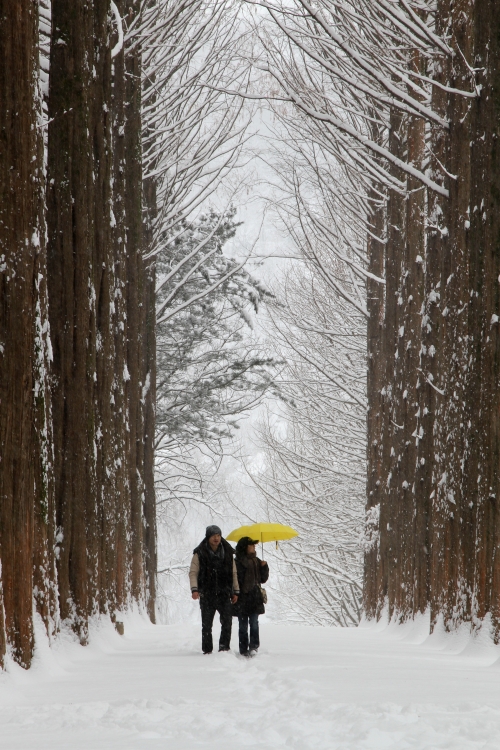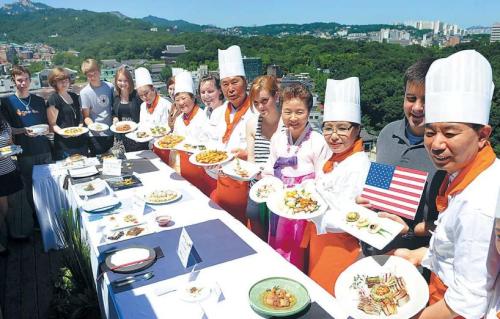‘Winter Sonata’ boosts Nami Island tourism while interest in hansik grows through ‘Daejanggeum’
This is third of a five-part series on hallyu. ― Ed.
Buoyed by “hallyu,” or the Korean Wave, Korean dramas are stretching their influence beyond the small screen and affecting other industries, including tourism and food.
KBS TV drama series “Winter Sonata,” for example, the drama which started the wave 10 years ago, brought an explosive growth in foreign tourists to South Korea.
The number of visitors to Nami Island in Chuncheon, Gangwon Province, in particular, shot up from about 270,000 in 2001 to 650,000 in 2002, right after the drama was broadcast. The number is still growing, marking 2.3 million last year.
The island was one of the filming locations of “Winter Sonata,” especially famous for the snow-covered Metasequoia path the main characters Jun-sang (actor Bae Yong-joon) and Yu-jin (actress Choi Ji-woo) strolled along.
This is third of a five-part series on hallyu. ― Ed.
Buoyed by “hallyu,” or the Korean Wave, Korean dramas are stretching their influence beyond the small screen and affecting other industries, including tourism and food.
KBS TV drama series “Winter Sonata,” for example, the drama which started the wave 10 years ago, brought an explosive growth in foreign tourists to South Korea.
The number of visitors to Nami Island in Chuncheon, Gangwon Province, in particular, shot up from about 270,000 in 2001 to 650,000 in 2002, right after the drama was broadcast. The number is still growing, marking 2.3 million last year.
The island was one of the filming locations of “Winter Sonata,” especially famous for the snow-covered Metasequoia path the main characters Jun-sang (actor Bae Yong-joon) and Yu-jin (actress Choi Ji-woo) strolled along.

“Like most tourism spots in Korea, December to March used to be the low season in Nami Island (before “Winter Sonata”). Now we welcome more than 3,000 on weekdays and more than 7,000 on weekends and holidays even in the winter season,” said Kim Geon-hee, a PR official at Nami Island.
Among the 2.3 million who visited the island last year, 420,000 were foreign tourists. Middle-aged Japanese women smitten with Bae, who played the romantic hero of the love saga, made up a significant number until 2003.
Since then, however, visitors from Thailand started to outnumber those from Japan. Nami Island officials find the reason not only in “Winter Sonata” but also“Hello Stranger,” a mega-hit Thai romantic comedy film which was filmed there.
The most popular spot in the island, of course, is the picturesque Metasequoia road. Hallyu fans also look for the spot where the “Winter Sonata” couple first kissed or where the statue of the famous couple stands. The Winter Sonata Gallery is also a must-visit spot for drama enthusiasts.
The biggest reason foreign visitors come to Korea is to find traces of Korean dramas, explained Kim.
“But such places are not so well-preserved in Korea, except for several indoor/outdoor sets which barely last three years. That is why Nami Island is so popular. For many living in Asian countries like China, Malaysia, Taiwan or Thailand, the second most familiar city in South Korea after Seoul is Nami Island. Our CEO Kang Woo-hyun received a wild round of applause when he visited a university in Malaysia to deliver a speech and introduced where he worked. Many of the students had visited Nami Island,” Kim added.
Other filming locations that became landmarks thanks to ardent hallyu fans include the outdoor set in Yangju, Gyeonggi Province, which was turned into a 6,600 square meter “Daejanggeum Theme Park,” Jeju Folk Museum and Songak Mountain on Jeju Island where the shooting for 2003 MBC drama “Daejanggeum,” or “Jewel in the Palace,” took place; and the indoor set near Seopjikoji on Jeju Island named “All In House” where the 2003 SBS drama “All In” was filmed.
While “Winter Sonata” drew foreign tourists, “Daejanggeum” excited the curiosity of gourmets across the world to “hansik,” or Korean food.
The drama introduced royal cuisine of the Joseon Dynasty to 87 countries it was exported to, as of May 2011. Featuring the main character Jang-geum (Lee Young-ae), a young palace girl from a lower-class background who successfully works her way up to become a personal physician of the king, the drama was full of appetite-stimulating Korean dishes ― clear but deeply flavored soups, well-seasoned meats, piquant side dishes and sweetened desserts.

The dishes were cooked up based on historical records of the time like Lady Jang’s cookbook “Eumsik Dimibang” or court physician Heo Jun’s “Dongui Bogam,” a traditional medical book, according to Han Bok-ryeo, researcher of Korean royal court cuisine, who advised during the making of the drama.
“‘Daejanggeum’ served as the center of hallyu and brought forth immense success in industries including cuisine, literature, animation, gaming and tourism. It enhanced the image of Korea in many countries not only in Asia but also in the Middle East, Europe and North America,” said Han at a policy debate held in November at the National Assembly.
Not missing a beat, the government stepped in to promote hansik by launching Korean Cuisine Promotion Teams not long after the drama started to gain popularity overseas. Different Korean restaurants chipped in on the plan as well and opened up branches overseas, which succeeded in setting a positive image of hansik.
Now “bibimbap,” or rice mixed with vegetables and meat, and kimchi are well-known dishes throughout the globe. World Health Organization named hansik as healthy and well-balanced in 2004 and U.S. magazine “Health” picked kimchi as one of the world’s five healthiest dishes.
“Dishes that fuse many different cultures like kimchi taco or bulgogi taco are really popular in New York right now, from on the streets to high-end restaurants. This was a great opportunity to get to know all about the current trend in hansik,” said Kim Jeong-min, a New York-based cook who organized “Kimchi Pasta” at an event held by the Institute of Traditional Korean Food in July.
About 50 cooks and expats from different cities such as Tokyo, Hong Kong, New York, Paris and London gathered for the event at the institute in Waryong-dong, central Seoul, to cook and taste fusion hansik.
To meet the growing interest in Korean food and to better promote it, the institute also published a cookbook introducing 100 best-loved recipes of Korean food in seven different languages including Korean, English, Japanese, Chinese, French, Czech and Spanish.
“To maintain the increased interest in hansik, it is important to teach and distribute cookbooks that contain standard recipes to foreigners visiting Korea and those who wish to learn Korean cuisine, free of charge,” said Kim Yu-ri, a PR official at the Institute of Traditional Korean Food.
By Park Min-young (claire@heraldcorp.com)
-
Articles by Korea Herald








![[Graphic News] More Koreans say they plan long-distance trips this year](http://res.heraldm.com/phpwas/restmb_idxmake.php?idx=644&simg=/content/image/2024/04/17/20240417050828_0.gif&u=)
![[KH Explains] Hyundai's full hybrid edge to pay off amid slow transition to pure EVs](http://res.heraldm.com/phpwas/restmb_idxmake.php?idx=644&simg=/content/image/2024/04/18/20240418050645_0.jpg&u=20240419100350)






![[From the Scene] Monks, Buddhists hail return of remains of Buddhas](http://res.heraldm.com/phpwas/restmb_idxmake.php?idx=652&simg=/content/image/2024/04/19/20240419050617_0.jpg&u=20240419175937)

![[KH Explains] Hyundai's full hybrid edge to pay off amid slow transition to pure EVs](http://res.heraldm.com/phpwas/restmb_idxmake.php?idx=652&simg=/content/image/2024/04/18/20240418050645_0.jpg&u=20240419100350)

![[Today’s K-pop] Illit drops debut single remix](http://res.heraldm.com/phpwas/restmb_idxmake.php?idx=642&simg=/content/image/2024/04/19/20240419050612_0.jpg&u=)